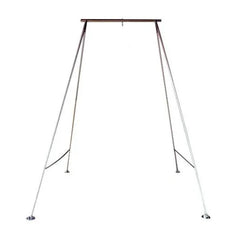Aerial arts are all about creativity, fun, and experiencing life from a new and unique perspective. As we learn to defy gravity, we learn to make our own rules. Friendship and community also play a vital role in our upside-down world. What better way to celebrate these values than to fly free out in the open air?
For many aerialists and aerial yogis, an outdoor setup is ideal for the practice. It’s true that a portable rig makes aerial arts accessible in virtually any location. It can open doors to opportunities and offer rigging solutions to that familiar dilemma: where to find space to work.
But portability is only one of the advantages to rehearsing, teaching, and/or performing in the fresh air. The approach also provides many other perks to consider. Here are just a few:
Maybe you are a performer or an instructor who travels near and far to share your gifts and talents with the world. Setting up outside in a public area is a great way to show off your skills and attract potential new clients or students. Just be sure you have permission to use the space first!
Participate in outdoor festivals or park events and put your work in front of a larger audience. As many of us know, children are absolutely enchanted by aerial arts, and you’ll find many of them at the park.
You can turn your backyard into an outdoor studio where you may have a bit more space to work than in a room inside.
Flying in the sun is totally fun. But keep these things in mind:
Although many aerialists avoid lotions and oils, it’s still a good idea to wear sunscreen when you’re working outside. You can always clean your apparatus after the session.
Check the weather forecast. We promise you: it’s no fun to strike a rig in the rain! Avoid practicing in excessive heat, or in high UV Indexes; aside from damaging your skin, UV can cause premature fading of aerial fabric.
Aerial rigs are great for short term use outside. But they are not always designed for outdoor storage. While sturdy, a rig may weather with exposure to moisture. There are metal protectant sprays that can help to protect the rig, and some aerialists use a tarp if keeping the rig standing overnight. Your best bet with your valuable investment is to keep it away from rain and moisture as much as possible. The more moist and humid your environment, the more it may be prone to damage.
Do you want to bring your aerial rig to the beach? Be careful to avoid sand if you bring the rig to the beach - sand can clog telescopic legs and connections. Bring plenty of towels or even a tarp to put down to avoid sand spillage (and be warned, beaches make for beautiful photoshoots, but wind can make aerial arts more challenging!). Check with the manufacturer of your specific rig for any other specific needs when using in sand. Salt water can cause rust - we don’t recommend using the rig in saltwater, but if it gets wet, be sure to rinse it with fresh water and dry thoroughly.
If your rig parts have accumulated rust, you can contact us for replacement parts (please note our warranty doesn't cover rust, but you can purchase replacement parts at-cost).
And if you plan to fly outside, be sure to perform a thorough equipment check every time you set up and take down the rig. It’s great to get in the habit of this practice anyway, but with outdoor use, it’s important to catch any issues early.
Once you’ve put safety first, it’s great fun to find new spots to try out at the beach, the forest, or your own backyard. After all...in aerial arts, the sky’s the limit!
Cover image by Christina @christina.varela



Leave a comment